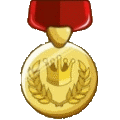The Rule of 3s - How to Master Your Market
 If I had to give you only ONE piece of advice to find success on your farm, it would be this:
If I had to give you only ONE piece of advice to find success on your farm, it would be this:
Run Your Market Well
Strong Marketing is your Farm's Secret Weapon:
- It is your main source of cash and materials to build, expand, and upgrade
- Bad marketing amplifies issues - it exposes your inefficiencies, lowers your income and materials, lowers your player tournament scores, hinders your ability to expand
- Simple fix - the majority of frustrations I see from players (low cash, slow progress, can't expand, poor tournament scores, always out of products) can be fixed by better marketing (or improving farm layout)
Building Your Market Strategy - The Rule of 3s
This strategy focuses on making smart choices about what you sell and when you sell it, based on its difficulty to produce versus the importance of the materials you receive.
Your focus while using this strategy should be on expanding your farm, doing the easy upgrades, and planning for the major product lines in the game.
Step 1 - Prioritizing Building Materials
 The first thing we do is categorize all building materials based on their overall importance and long-term value. The example I give (in brackets after each category) will work for most farms through most of the game.
The first thing we do is categorize all building materials based on their overall importance and long-term value. The example I give (in brackets after each category) will work for most farms through most of the game.
- High focus (saws, books, nails, boards)
- Medium focus (glass, ink, scrolls)
- Low focus.(bricks, tiles)
Step 2 - Prioritize Products by Scarcity
 Next, we categorize your farm products based on how difficult they are to keep stocked. This will naturally vary depending on how you play, your level, and how you build your farm. It is so varied, I will give two examples:
Next, we categorize your farm products based on how difficult they are to keep stocked. This will naturally vary depending on how you play, your level, and how you build your farm. It is so varied, I will give two examples:
Starting farm (Level 1 to 30)
- Hard - milk, cherries, almonds
- Medium - cheese, eggs,
- Easy - crops, apples, pigs
Mature farm (Level 200+)
- Hard - horses, white wool
- Medium - honey, gray wool, cherries, pigs, feathers, dairy goods, tailor goods, jam
- Easy - eggs, milk, cheese, crops, apples, peaches, white tailor goods, bakery goods, sheep wool
Step 3 - Line It All Up (The Strategy)
The final step is matching the scarcity of your product (Step 2) with the priority of the material (Step 1). This ensures your rarest products are only used for your most valuable materials.
- Hard-to-get products are used ONLY for High focus materials
- Medium-to-get products are used for Medium and High focus materials
- Easy-to-get products are used for Low, Medium and High focus materials
So that means a level 25 farm using this strategy would send milk in a contract for saws or nails, but not for bricks.
The Magic - A Self Balancing System
 Defining Hard, Medium and Easy to get products changes as you harvest and market, based on how many you have in your barn. If your barn holds 1500 milk, and you have 1500 milk, that would be ‘easy’ to get and can be used on any contract. Once it drops to 1000, then it’s medium and you wouldn’t use it for bricks. If it gets down to 500, then you want to save it for only high focus items. Items like horses or white wool that sell in lower quantities will have different thresholds. Sometimes you can say 'I have 700 horses. I can afford to send that ink contract'.
Defining Hard, Medium and Easy to get products changes as you harvest and market, based on how many you have in your barn. If your barn holds 1500 milk, and you have 1500 milk, that would be ‘easy’ to get and can be used on any contract. Once it drops to 1000, then it’s medium and you wouldn’t use it for bricks. If it gets down to 500, then you want to save it for only high focus items. Items like horses or white wool that sell in lower quantities will have different thresholds. Sometimes you can say 'I have 700 horses. I can afford to send that ink contract'.
After a few players proof read this post, they commented that product [fill in the blank] should be Medium-to-get because... They are 100% right. You need to define your hard, medium, and easy-to-get.
Flexibility - Changing your focus
Your focus can also change as you play the game. You should always strive to expand, but maybe you are 10,000 bricks away from an upgrade you really want. Make bricks high focus for a few days to bring in the bricks you need.
The Insatiable Market Trap
The most frustrating thing about the market is that it is insatiable; every time you send a contract, another will be waiting, guaranteeing that you will never have enough products. This prompts players to take short-sighted, damaging actions.
 I see a lot of farms that slowly slip into negative happiness just to add one more production building to try and satisfy market demand. From there, it is one more building, then another, until players are running the worst happiness levels in the game (often between $-400$ and $-600$). This severely hinders your cash flow and stalls out upgrades and expansions, making the game even more frustrating. (These farms begin to grow again once they make some sacrifices to get their happiness up again.)
I see a lot of farms that slowly slip into negative happiness just to add one more production building to try and satisfy market demand. From there, it is one more building, then another, until players are running the worst happiness levels in the game (often between $-400$ and $-600$). This severely hinders your cash flow and stalls out upgrades and expansions, making the game even more frustrating. (These farms begin to grow again once they make some sacrifices to get their happiness up again.)
Once your products drop into the Medium or Hard categories (based on the Rule of 3s), stop sending non-critical contracts. Do not sacrifice your farm's health (happiness and cash flow) for a market that offers infinite, unfulfillable demand.
Chasing Cash - Identifying High-Value Contracts
 A common dynamic in games is the intentional creation of a resource crunch—giving you more to handle than you can easily manage—to encourage purchasing solutions.
A common dynamic in games is the intentional creation of a resource crunch—giving you more to handle than you can easily manage—to encourage purchasing solutions.
When you level up (by gaining XP), it opens new products that demand more space, more workers (space), and more cash to build.
You will notice that roughly 45% of contracts give you only 67% of the money, but award 255% more player XP.
- Player XP feels good and shows accomplishment, but it also makes the game harder by opening new products.
- The result is a dynamic where you are constantly pushed to expand and need cash, but the game has intentionally been giving you less cash in your trades.
Since this dynamic intentionally pushes you toward purchasing solutions, we will use it to further evaluate when to trash a contract. We only want to spend valuable products on trades that yield the greatest return, whether that's essential materials or full cash value. I personally don’t want to send $56,250 worth of honey for $38,250 on a scroll contract. I would do that for saws, but not scrolls. Once you pass level 150 to 160, the upgrades become so material expensive that cash becomes less and less of a struggle, so high value vs high XP becomes a moot point.
Quick-Check Method for Contract Value
How do you quickly tell the difference? Look at the first 2 numbers of the cash and player XP. If they are close (11 and 13, or 32 and 30), it is a full cash value contract. If they are 4x apart (11 and 46) then it’s a high XP contract.
Advanced Tactics - Player Tournament
 When competing in player tournaments, the primary goal shifts from resource optimization to maximizing contract volume and speed, as most of your points are generated from sending contracts. To achieve this, temporarily adjust the "Rule of 3s" to a more aggressive contracting strategy:
When competing in player tournaments, the primary goal shifts from resource optimization to maximizing contract volume and speed, as most of your points are generated from sending contracts. To achieve this, temporarily adjust the "Rule of 3s" to a more aggressive contracting strategy:
- Hard-to-get products are used for High and Medium priority materials
- Medium-to-get products are used for Low, Medium and High focus materials
- Easy-to-get products are used for Low, Medium and High focus materials
For even greater success, push your market XP bonus. A level 45 bonus will give you roughly 50% higher tournament score.
Extremely competitive? Buy what you need from the barn (easy to get but extremely expensive) to send every contract.
This strategy naturally stocks up hard-to-get products on co-op tournament week for a more impactful player tournament week.
Applying the Strategy - Dream Farm Dynamic
 Dream Farm presents a different market dynamic, extreme scarcity of produce, but the Rules of 3s strategy still applies. (Below assumes you are doing more than Easy Mode.)
Dream Farm presents a different market dynamic, extreme scarcity of produce, but the Rules of 3s strategy still applies. (Below assumes you are doing more than Easy Mode.)
When the farm starts, you have extremely limited produce to sell. My focus on the first session is 1 of scrolls, ink, nails, boards (expansion and fields). Once I have sent a scroll contract, it becomes zero focus, and I hunt for the other 3 items.
Don’t use cherries (hard to get items) on materials you don’t need. Save them purely for your first book, glass, or saw contract.
Then I start looking for 500 of each building material. As I get closer to 500, the focus goes down, so I use easier to get produce to fill those contracts and save hard to get stuff for my lowest quantities. Then I’ll go for 1000 of each.
At this point, you have a solid dream farm with land, stables, orchards, and fields. When you are running 3-4 upgraded apples and 5-7 pigs, you can just send contracts with easy and medium to get products until you have 13,000 to 19,000 (use the Dream Farm calculator to find your exact numbers) of each to rapidly upgrade your farmhouse on the last day. You only chase specific items the first 6 contracts, and your last day when you are trying to get those last items.
New Products Start Scarce
 Every time a new production cycle is added as you level up, the item will start as scarce and hard-to-get. The worst example is honey at level 67 and we lose a lot of unprepared players here. You need mallets to upgrade orchards (and fields at level 68) and build the beehive, both having long upgrade times and it takes a while to collect nectar. You can read about how to prepare for the honey supply chain so you won’t get frustrated. Honey will become a premium item, and you only want to use it on your most valuable and precious materials.
Every time a new production cycle is added as you level up, the item will start as scarce and hard-to-get. The worst example is honey at level 67 and we lose a lot of unprepared players here. You need mallets to upgrade orchards (and fields at level 68) and build the beehive, both having long upgrade times and it takes a while to collect nectar. You can read about how to prepare for the honey supply chain so you won’t get frustrated. Honey will become a premium item, and you only want to use it on your most valuable and precious materials.
Horses are a luxury item introduced at level 42. They take a lot of time to produce (feed and horses), use apples (expensive items) in the feed, and have very low yields. They are the best profit per time and profit per space. However, they are hard to get, so you will want to limit them to high focus material contracts, unless you have a good routine and lots of horse stables.
Small Contracts - The Efficiency Advantage
You may have noticed I haven’t said anything about the size of a contract. The worst thing you can do is fall into the mindset that large contracts are better.
Every product has a fixed value, so a pig will pay $6.25 if it’s in a $1,000 contract or a $10,000 contract.
The smaller the contract, the better the impact of your bonuses (plus they are easier to fill). Who wouldn't want to send 100 wildflowers for 1 + 50 nails?
Don't Wait for Contracts
 While the temptation is to hold onto a contract for a high-priority material or a rare product, stalling your market flow is the biggest drain on efficiency. If you can't fill it in the next 20 mins, trash it.
While the temptation is to hold onto a contract for a high-priority material or a rare product, stalling your market flow is the biggest drain on efficiency. If you can't fill it in the next 20 mins, trash it.
By using this strategy, you will drastically decrease running out of items for high value materials.
Ad Contracts
Roughly 9% of contracts will be for an ad. Always process your ad contracts first because:
- they have a skewed chance of rarer materials and
- you can only get an ad contract if you don't already have one.
You can either trash them (and they regenerate instantly), or watch the ad to send it.
Demystifying Timed Contracts
Big Farm introduced timed contracts that you need to fill in one or two hours. While they are designed to look urgent and valuable, they are actually less efficient. They are simply a regular contract, but require 2 to 3 times higher quantities of each item. The product value is exactly the same, but you lose the bonus effects on 1 to 2 contracts. Timed Contracts are strategically designed to be "smoke and mirrors," attempting to induce spending to fill them before the timer runs out. Do not feel pressured to complete them. The financial and efficiency loss is not worth the perceived value.
(Note: They are the only contracts that can request crops beyond wildflowers for players over level 100.)
(Note: For players over level 100, there is also a variant that takes 10 times more white wool and give mallets. While mallets are very hard to get (F2P), I find skipping these contracts better for market flow and overall growth.)
The Ship - Maximizing Cash & Boosters
 The Ship offers an additional way to sell your goods, shifting your primary reward focus from materials (contracts) to cash, boosters, and cargo coins (used for boosters). You receive 1 ship every 5 hours, and have 15 hours to fill it. Each ship has 3 cargo holds, each requiring the same 2 to 5 products. Each product pays more than selling in the barn, but less than selling in the market (before bonuses). The next ship will tell you what items it will need during the 15 hour cool down.
The Ship offers an additional way to sell your goods, shifting your primary reward focus from materials (contracts) to cash, boosters, and cargo coins (used for boosters). You receive 1 ship every 5 hours, and have 15 hours to fill it. Each ship has 3 cargo holds, each requiring the same 2 to 5 products. Each product pays more than selling in the barn, but less than selling in the market (before bonuses). The next ship will tell you what items it will need during the 15 hour cool down.
The true value of the Ship lies in the bonuses for completion. You get a bonus for each cargo hold you fill, potentially giving you up to 2.5 times more cash per item than its market value. If you fill the entire ship, you will receive a mystery chest with boosters and Cargo Coins (used to buy boosters in the booster shop). It is important to understand that no materials are ever rewarded for using the ship.
The Ship Rule: All or Nothing
With the Ship, you want to evaluate all the products (their scarcity) together and then either commit to filling it, or send it away empty because you lose the bonuses with a partially filled ship. One Hard-to-get product will sink the whole ship.
There is the rare time when you can sell excess stock to the ship instead of selling in the barn, which would validate sending a partial ship. There are also quests to fill single cargo holds.
The Train - Cash King, Material Killer
 The train is a very high commitment mechanism to sell farm produce for the highest cash and no materials. It takes a week because it requires insanely high quantities of products. The train has 7 cars with 2 crates each. You get paid NOTHING for each product loaded onto the train. You have to complete both crates to fill a car, and you have to complete 2 cars to make any money, which is less than the market. You don't make a profit unless you complete 5 or all 7 cars.
The train is a very high commitment mechanism to sell farm produce for the highest cash and no materials. It takes a week because it requires insanely high quantities of products. The train has 7 cars with 2 crates each. You get paid NOTHING for each product loaded onto the train. You have to complete both crates to fill a car, and you have to complete 2 cars to make any money, which is less than the market. You don't make a profit unless you complete 5 or all 7 cars.
I've observed a trend where players build their farm and workers towards filling the train (more fields and fuller meadow supply chain). If you put that same land and workers towards core production buildings like stables and orchards, in many cases, the cash that would be generated through market sales is fairly close to the same, but you would also generate materials. I think the train serves as more of a resource crunch to stall your farm and encourage panic spending.
The strategic use for trains is an infusion of player tournament points.
You are in Control
We started with a single piece of advice: run your market well. This simple strategy gives you the tools to execute that advice perfectly. By dynamically matching the scarcity of your products to the priority of your materials, you ensure that every contract you send is optimal for expanding, upgrading, profit, and competitive points.


